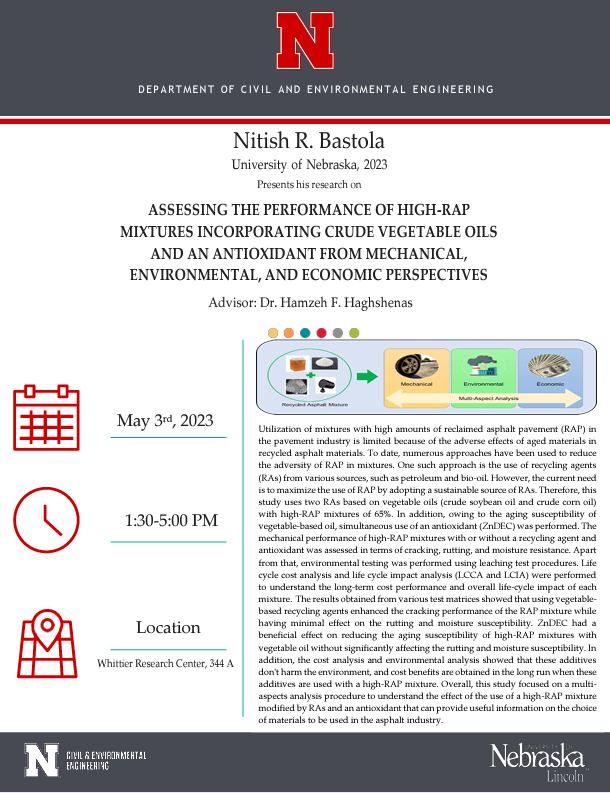
Nitish R. Bastola
University of Nebraska, 2023
Presents his research on
ASSESSING THE PERFORMANCE OF HIGH-RAP MIXTURES INCORPORATING CRUDE VEGETABLE OILS AND AN ANTIOXIDANT FROM MECHANICAL, ENVIRONMENTAL, AND ECONOMIC PERSPECTIVES
Advisor: Dr. Hamzeh F. Haghshenas
May 3rd, 2023
1:30-5:00 PM
Whittier Research Center, 344 A
Utilization of mixtures with high amounts of reclaimed asphalt pavement (RAP) in the pavement industry is limited because of the adverse effects of aged materials in recycled asphalt materials. To date, numerous approaches have been used to reduce the adversity of RAP in mixtures. One such approach is the use of recycling agents (RAs) from various sources, such as petroleum and bio-oil. However, the current need is to maximize the use of RAP by adopting a sustainable source of RAs. Therefore, this study uses two RAs based on vegetable oils (crude soybean oil and crude corn oil) with high-RAP mixtures of 65%. In addition, owing to the aging susceptibility of vegetable-based oil, simultaneous use of an antioxidant (ZnDEC) was performed. The mechanical performance of high-RAP mixtures with or without a recycling agent and antioxidant was assessed in terms of cracking, rutting, and moisture resistance. Apart from that, environmental testing was performed using leaching test procedures. Life cycle cost analysis and life cycle impact analysis (LCCA and LCIA) were performed to understand the long-term cost performance and overall life-cycle impact of each mixture. The results obtained from various test matrices showed that using vegetable based recycling agents enhanced the cracking performance of the RAP mixture while having minimal effect on the rutting and moisture susceptibility. ZnDEC had a beneficial effect on reducing the aging susceptibility of high-RAP mixtures with vegetable oil without significantly affecting the rutting and moisture susceptibility. In addition, the cost analysis and environmental analysis showed that these additives don't harm the environment, and cost benefits are obtained in the long run when these additives are used with a high-RAP mixture. Overall, this study focused on a multi-aspects analysis procedure to understand the effect of the use of a high-RAP mixture modified by RAs and an antioxidant that can provide useful information on the choice of materials to be used in the asphalt industry.